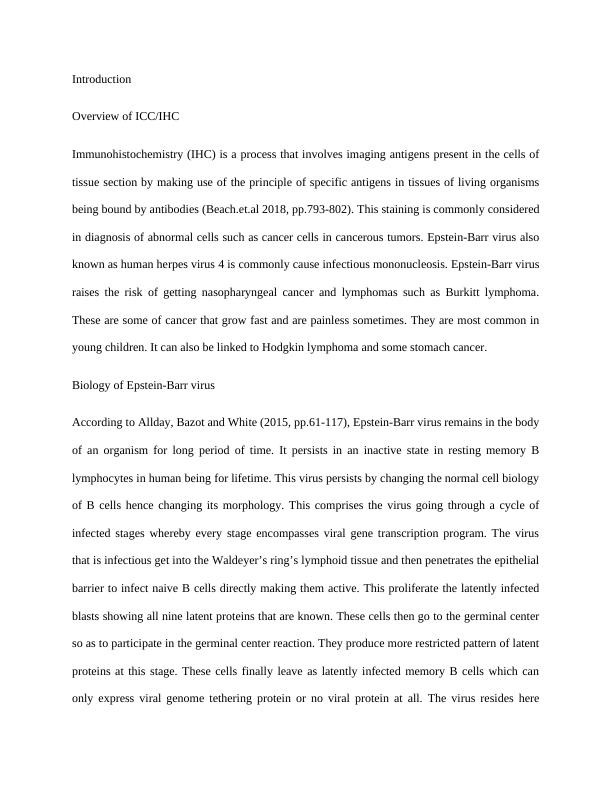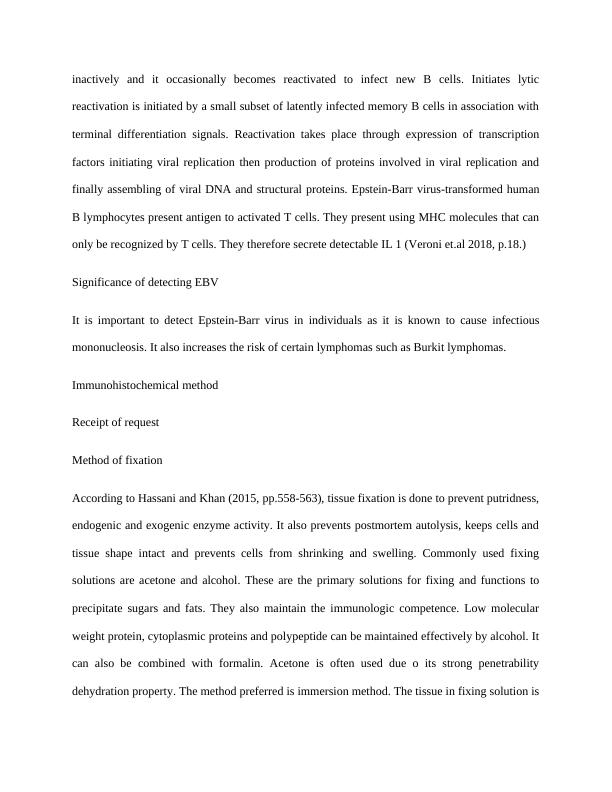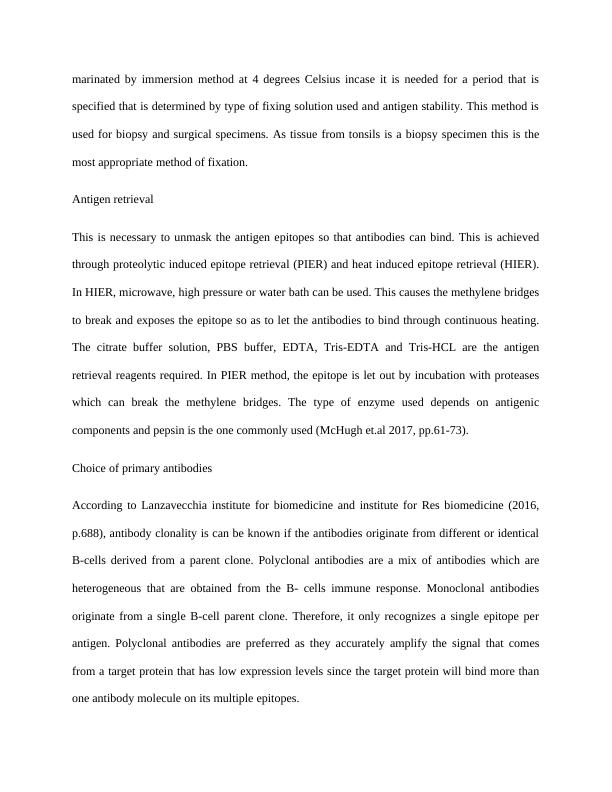Immunohistochemistry for Detection of Epstein-Barr Virus in Tissue
Added on 2023-05-28
12 Pages2610 Words319 Views
Tissue science:
Student name:
Institutional affiliation:
Student name:
Institutional affiliation:

Introduction
Overview of ICC/IHC
Immunohistochemistry (IHC) is a process that involves imaging antigens present in the cells of
tissue section by making use of the principle of specific antigens in tissues of living organisms
being bound by antibodies (Beach.et.al 2018, pp.793-802). This staining is commonly considered
in diagnosis of abnormal cells such as cancer cells in cancerous tumors. Epstein-Barr virus also
known as human herpes virus 4 is commonly cause infectious mononucleosis. Epstein-Barr virus
raises the risk of getting nasopharyngeal cancer and lymphomas such as Burkitt lymphoma.
These are some of cancer that grow fast and are painless sometimes. They are most common in
young children. It can also be linked to Hodgkin lymphoma and some stomach cancer.
Biology of Epstein-Barr virus
According to Allday, Bazot and White (2015, pp.61-117), Epstein-Barr virus remains in the body
of an organism for long period of time. It persists in an inactive state in resting memory B
lymphocytes in human being for lifetime. This virus persists by changing the normal cell biology
of B cells hence changing its morphology. This comprises the virus going through a cycle of
infected stages whereby every stage encompasses viral gene transcription program. The virus
that is infectious get into the Waldeyer’s ring’s lymphoid tissue and then penetrates the epithelial
barrier to infect naive B cells directly making them active. This proliferate the latently infected
blasts showing all nine latent proteins that are known. These cells then go to the germinal center
so as to participate in the germinal center reaction. They produce more restricted pattern of latent
proteins at this stage. These cells finally leave as latently infected memory B cells which can
only express viral genome tethering protein or no viral protein at all. The virus resides here
Overview of ICC/IHC
Immunohistochemistry (IHC) is a process that involves imaging antigens present in the cells of
tissue section by making use of the principle of specific antigens in tissues of living organisms
being bound by antibodies (Beach.et.al 2018, pp.793-802). This staining is commonly considered
in diagnosis of abnormal cells such as cancer cells in cancerous tumors. Epstein-Barr virus also
known as human herpes virus 4 is commonly cause infectious mononucleosis. Epstein-Barr virus
raises the risk of getting nasopharyngeal cancer and lymphomas such as Burkitt lymphoma.
These are some of cancer that grow fast and are painless sometimes. They are most common in
young children. It can also be linked to Hodgkin lymphoma and some stomach cancer.
Biology of Epstein-Barr virus
According to Allday, Bazot and White (2015, pp.61-117), Epstein-Barr virus remains in the body
of an organism for long period of time. It persists in an inactive state in resting memory B
lymphocytes in human being for lifetime. This virus persists by changing the normal cell biology
of B cells hence changing its morphology. This comprises the virus going through a cycle of
infected stages whereby every stage encompasses viral gene transcription program. The virus
that is infectious get into the Waldeyer’s ring’s lymphoid tissue and then penetrates the epithelial
barrier to infect naive B cells directly making them active. This proliferate the latently infected
blasts showing all nine latent proteins that are known. These cells then go to the germinal center
so as to participate in the germinal center reaction. They produce more restricted pattern of latent
proteins at this stage. These cells finally leave as latently infected memory B cells which can
only express viral genome tethering protein or no viral protein at all. The virus resides here

inactively and it occasionally becomes reactivated to infect new B cells. Initiates lytic
reactivation is initiated by a small subset of latently infected memory B cells in association with
terminal differentiation signals. Reactivation takes place through expression of transcription
factors initiating viral replication then production of proteins involved in viral replication and
finally assembling of viral DNA and structural proteins. Epstein-Barr virus-transformed human
B lymphocytes present antigen to activated T cells. They present using MHC molecules that can
only be recognized by T cells. They therefore secrete detectable IL 1 (Veroni et.al 2018, p.18.)
Significance of detecting EBV
It is important to detect Epstein-Barr virus in individuals as it is known to cause infectious
mononucleosis. It also increases the risk of certain lymphomas such as Burkit lymphomas.
Immunohistochemical method
Receipt of request
Method of fixation
According to Hassani and Khan (2015, pp.558-563), tissue fixation is done to prevent putridness,
endogenic and exogenic enzyme activity. It also prevents postmortem autolysis, keeps cells and
tissue shape intact and prevents cells from shrinking and swelling. Commonly used fixing
solutions are acetone and alcohol. These are the primary solutions for fixing and functions to
precipitate sugars and fats. They also maintain the immunologic competence. Low molecular
weight protein, cytoplasmic proteins and polypeptide can be maintained effectively by alcohol. It
can also be combined with formalin. Acetone is often used due o its strong penetrability
dehydration property. The method preferred is immersion method. The tissue in fixing solution is
reactivation is initiated by a small subset of latently infected memory B cells in association with
terminal differentiation signals. Reactivation takes place through expression of transcription
factors initiating viral replication then production of proteins involved in viral replication and
finally assembling of viral DNA and structural proteins. Epstein-Barr virus-transformed human
B lymphocytes present antigen to activated T cells. They present using MHC molecules that can
only be recognized by T cells. They therefore secrete detectable IL 1 (Veroni et.al 2018, p.18.)
Significance of detecting EBV
It is important to detect Epstein-Barr virus in individuals as it is known to cause infectious
mononucleosis. It also increases the risk of certain lymphomas such as Burkit lymphomas.
Immunohistochemical method
Receipt of request
Method of fixation
According to Hassani and Khan (2015, pp.558-563), tissue fixation is done to prevent putridness,
endogenic and exogenic enzyme activity. It also prevents postmortem autolysis, keeps cells and
tissue shape intact and prevents cells from shrinking and swelling. Commonly used fixing
solutions are acetone and alcohol. These are the primary solutions for fixing and functions to
precipitate sugars and fats. They also maintain the immunologic competence. Low molecular
weight protein, cytoplasmic proteins and polypeptide can be maintained effectively by alcohol. It
can also be combined with formalin. Acetone is often used due o its strong penetrability
dehydration property. The method preferred is immersion method. The tissue in fixing solution is

marinated by immersion method at 4 degrees Celsius incase it is needed for a period that is
specified that is determined by type of fixing solution used and antigen stability. This method is
used for biopsy and surgical specimens. As tissue from tonsils is a biopsy specimen this is the
most appropriate method of fixation.
Antigen retrieval
This is necessary to unmask the antigen epitopes so that antibodies can bind. This is achieved
through proteolytic induced epitope retrieval (PIER) and heat induced epitope retrieval (HIER).
In HIER, microwave, high pressure or water bath can be used. This causes the methylene bridges
to break and exposes the epitope so as to let the antibodies to bind through continuous heating.
The citrate buffer solution, PBS buffer, EDTA, Tris-EDTA and Tris-HCL are the antigen
retrieval reagents required. In PIER method, the epitope is let out by incubation with proteases
which can break the methylene bridges. The type of enzyme used depends on antigenic
components and pepsin is the one commonly used (McHugh et.al 2017, pp.61-73).
Choice of primary antibodies
According to Lanzavecchia institute for biomedicine and institute for Res biomedicine (2016,
p.688), antibody clonality is can be known if the antibodies originate from different or identical
B-cells derived from a parent clone. Polyclonal antibodies are a mix of antibodies which are
heterogeneous that are obtained from the B- cells immune response. Monoclonal antibodies
originate from a single B-cell parent clone. Therefore, it only recognizes a single epitope per
antigen. Polyclonal antibodies are preferred as they accurately amplify the signal that comes
from a target protein that has low expression levels since the target protein will bind more than
one antibody molecule on its multiple epitopes.
specified that is determined by type of fixing solution used and antigen stability. This method is
used for biopsy and surgical specimens. As tissue from tonsils is a biopsy specimen this is the
most appropriate method of fixation.
Antigen retrieval
This is necessary to unmask the antigen epitopes so that antibodies can bind. This is achieved
through proteolytic induced epitope retrieval (PIER) and heat induced epitope retrieval (HIER).
In HIER, microwave, high pressure or water bath can be used. This causes the methylene bridges
to break and exposes the epitope so as to let the antibodies to bind through continuous heating.
The citrate buffer solution, PBS buffer, EDTA, Tris-EDTA and Tris-HCL are the antigen
retrieval reagents required. In PIER method, the epitope is let out by incubation with proteases
which can break the methylene bridges. The type of enzyme used depends on antigenic
components and pepsin is the one commonly used (McHugh et.al 2017, pp.61-73).
Choice of primary antibodies
According to Lanzavecchia institute for biomedicine and institute for Res biomedicine (2016,
p.688), antibody clonality is can be known if the antibodies originate from different or identical
B-cells derived from a parent clone. Polyclonal antibodies are a mix of antibodies which are
heterogeneous that are obtained from the B- cells immune response. Monoclonal antibodies
originate from a single B-cell parent clone. Therefore, it only recognizes a single epitope per
antigen. Polyclonal antibodies are preferred as they accurately amplify the signal that comes
from a target protein that has low expression levels since the target protein will bind more than
one antibody molecule on its multiple epitopes.

End of preview
Want to access all the pages? Upload your documents or become a member.
Related Documents
Immunohistochemistry for Identification of Epstein Barr Viruslg...
|7
|1815
|452